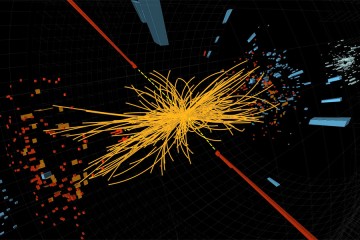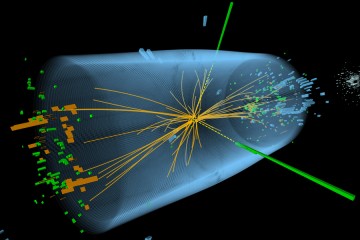Andrei Gritsan, a professor in the Department of Physics and Astronomy at Johns Hopkins, is a member of a large team of researchers at the Large Hadron Collider in Switzerland and France that, in 2012, announced the discovery of a new subatomic particle, a Higgs boson. Gritsan has been leading a group of physicists on the Compact Muon Spectrometer (CMS) experiment, a particle detector at the Large Hadron Collider.

Image caption: Johns Hopkins physicist Andrei Gritsan
He explained the significance of the long-sought Higgs particle and his contributions to the research that led to its discovery in July 2012.
What is the Higgs boson?
What we were actually after is the Higgs field, and the Higgs boson is like a wave in this field. In some ways the Higgs field is like the idea of ether, a medium in which waves travel. The more-than-a-century-old idea of ether appears to be wrong, but this idea, which is only half a century old, now appears to be correct. What we do in the laboratory, called the Large Hadron Collider, is to supply enough energy into this field, which is all around us, and create the Higgs bosons out of this field. The challenge was to actually "see" the bosons once they were created.
Why is it so important?
All elementary particles—either those from which we are made, or those which help to supply energy from the sun, for example—interact with the field and acquire mass. The way they acquire mass may have cosmological consequences for our existence. Our past, present, and future depend on the properties of this field. Should the field be only slightly different, we would never have come into existence. Should the field appear unstable, we would cease to exist in an instant. In fact, all indications are now that the field is metastable, which means that it is neither stable nor unstable, so we can only guess what will happen to our universe in the future.
It is also likely that the Higgs field interacts with the mysterious dark matter that dominates the matter content of our universe and remains a mystery. The Higgs field may also play a role with the dark energy that is driving the expansion of the universe. The connection to time reversal symmetry violation in the Higgs sector may be able to explain our matter-dominance in the universe. There are so many unanswered fundamental questions, and the Higgs field with its Higgs boson may play a gateway role to those mysteries.
What role did you play in its discovery?
The challenge was to actually "see" the Higgs bosons once they were created. One aspect is to make the scientific instrument—the CMS detector, in our case—as precise as possible. With my team at Hopkins and leading a group of several experts on the CMS experiment, I developed the methods to precisely "focus" the key system of the detector, the silicon tracking system, to "see" the Higgs boson traces. This involved precise understanding of alignment of more than 15,000 "digital cameras" to a micron precision without any direct access to those cameras.
I wrote an article about this, titled "Alignment of a Giant".
The other aspect was to use the above instrument to distinguish the traces of the Higgs boson from an overwhelming background of random debris during the collision of particles at the Large Hadron Collider. I led a group of physicists in developing the analysis of the Higgs boson decay to two Z-bosons. With my group at Hopkins, I also implemented the technique that uses information contained in the relative angles and momenta of the secondary particles produced when the very short-lived Higgs decays. We called it a MELA technique. The MELA technique alone boosted the significance of the observed signal from two standard deviations to more than three standard deviations in July 2012, bringing the observation above the threshold of discovery. An even more important consequence of this technique was to determine the properties of the discovered boson, leading to the conclusion that this was a Higgs boson, not some other kind of particle appearing in collisions.
A few articles I wrote about this:
- New boson's mirror image looks like the Higgs
- Hadron collisions reach out to people in Washington
- The weak mixing of light and heavy
What's next in the study of the boson?
The properties of the Higgs field, and as a consequence of the Higgs boson, are very important to understand to high precision. Details of those properties could help solve some of the mysteries of the universe, as I discussed earlier. We have already achieved a lot in understanding those properties just one year after the discovery, but we have a long way to go to achieve the desired goals. There could be sisters and brothers of this particle that would completely turn our understanding of the universe around. In some ways, this particle and its field are the cornerstone of our fundamental knowledge. It is present even if nothing else exists.
In parallel with the above studies, we have just completed a year long particle physics community planning exercise with the idea to assess the future directions of the field for one or two decades ahead. I have been co-leading the Higgs boson study group, and many interesting proposals are on the table now on how to proceed with understanding what appears to be a completely new form of matter-energy that we have never observed before.
Posted in Science+Technology
Tagged andrei gritsan, particle physics, higgs particle










